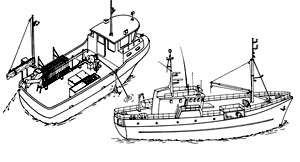 |
|
HOME 2001 PETITION NOAA-NMFS ICCAT-SCRS INDEPENDENT RESEARCH COMMERCIAL FISHERIES RECREATIONAL FISHING SUPPORTERS |
 |
|
HOME 2001 PETITION NOAA-NMFS ICCAT-SCRS INDEPENDENT RESEARCH COMMERCIAL FISHERIES RECREATIONAL FISHING SUPPORTERS |
|
|
|||||||||||||
|
|
|||||||||||||
|
|
|||||||||||||
|
PELAGIC LONGLINE FLEET |
PELAGIC LONGLINE FISHING - VARIED VIEWS |
|||||||||||
|
|
. | ||||||||||||
|
ICCAT's database currently lists 3,640 commercial longline vessels registered to fish the Atlantic. |
NOAA's description of the U.S. commercial fisheries including the pelagic longline fishery |
||||||||||||
 |
. | ||||||||||||
|
Blue Water Fishermen’s Association (BWFA) information on US Pelagic longline fishing |
|||||||||||||
| . | |||||||||||||
|
ICCAT Manual's extensive description of the pelagic longline fishery. |
|||||||||||||
|
United Nations resource on longline vessel types: Longliners, Factory Longliners, Freezer Longliners |
|||||||||||||
| A 1998 study of the pelagic longline fleet found that the average length of Atlantic pelagic longline vessels in 1996 was 57 feet (range 30-95 feet) (Larkin et al.1998). |
United Nations resource on longline gear: Set Longlines, Drifting longlines |
||||||||||||
|
|
|||||||||||||
|
|
|||||||||||||
|
Circle-hooks research in Commercial Fishing A VIMS study (Kerstetter, Graves 2006), with encouraging results on the use of Circle-hooks in commercial catches. |
|||||||||||||
|
|
|||||||||||||
 |
|||||||||||||